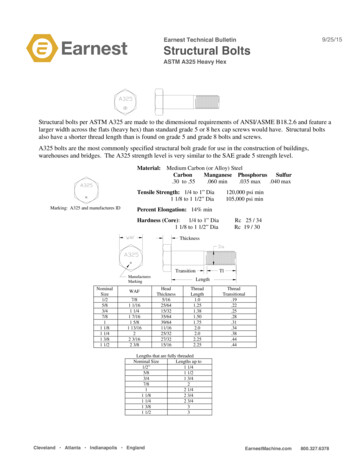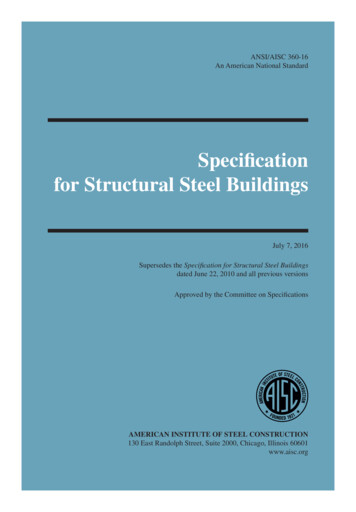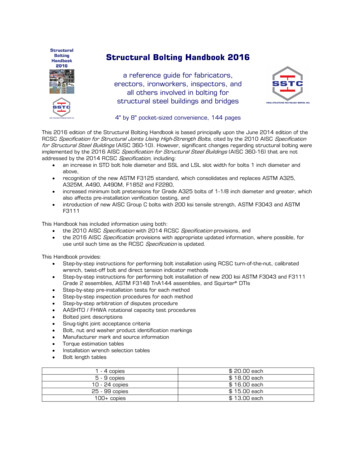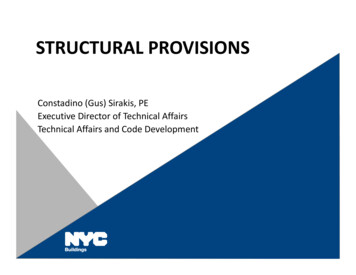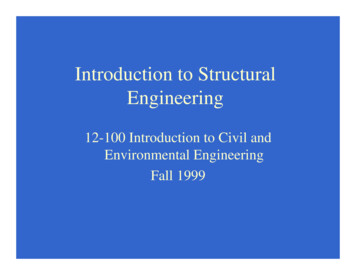
Transcription
Introduction to StructuralEngineering12-100 Introduction to Civil andEnvironmental EngineeringFall 1999
Outline Objective of Structural Engineering Structural Engineering Process Types of loads Types of structures Load paths in structures Summary
Civil Engineering Subdisciplines structural geotechnical environmental transportation construction
Objectives of StructuralEngineeringStructural engineering is the science and art of designingand making, with economy and elegance, buildings,bridges, frameworks, and other structures so that they cansafely resist the forces to which they may be subjected.The Structural Engineer,Official Journal of the British Institute ofStructural Engineers
Structural Engineering Process Determine types magnitudes of loads Determine structural context geometric and geological information cost / schedule / height/ etc. limitations Generate alternative structural systems Analyze one or more alternatives Select and perform detailed design Implement (usually done by contractor)
Types of loads Dead loads Live loads Dynamic loads (e.g., trains, equipment) Wind loads Earthquake loads Thermal loads Settlement loads
Dead Loads weight of the structure itself floors, beams, roofs, decks, beams/stringers,superstructure loads that are “always there”Photos courtesy of Corel, Inc.
Live Loads People, furniture, equipment Loads that may move orchange mass or weight Minimum design loadingsare usually specified inthe building codePhoto courtesy of Corel, Inc.Photo courtesy of Prof. P. Steif
Load Example: Live Load in BallroomBallroomLive Load 100 lb/ft 2
Dynamic Loads Moving loads (e.g. traffic) Impact loads Gusts of wind Loads due to cyclingmachineryPhoto courtesy of Corel, Inc.
Load Example: Dynamic LoadHVACFt
Load Example: Water in a damWater,ρ densityhp ρghPhoto courtesy of Corel, Inc.
Earthquake Loads Structure loaded when base is shaken Response of structure is dependent on thefrequency of motion When frequencies match with naturalfrequency of structure - resonance
Load Example: Earthquake LoadEarthquake LoadEarthquake LoadBase Motion
Structural Engineering International, Vol 5, No 1, 1995, pp.13
Photo courtesy of Corel, Inc.
SettlementJ. GarrettStructural Engineering International, Vol 7, No 3, 1997, pp.202
Some Types of Structures Arch Planar Truss Beam/Girder Braced Frame Rigid Frame Space Truss Cable Suspended Structure
Arch
J. GarrettPhotos courtesy of Corel, Inc.
Planar Truss
Photos courtesy of Corel, Inc.
Beam/Girder
Photos courtesy of Corel, Inc.Photo courtesy of Prof. P. Steif
FramesBracedRigid
Cable Suspended Structure
Cable Stayed Bridge
Load Paths in Structures Load Path is the term used to describe thepath by which loads are transmitted to thefoundations Different structures have different loadpaths Some structures have only one path Some have several (redundancy good)
Load Path in Framed Structure
Load Path in a Tied ArchCourtesy of Pennsylvania Department of Transportation
Summary Structural Engineering: identifies loads to be resisted identifies alternatives for providing load paths(arch, truss, frame, .) designs structure to provide safe andeconomical load paths (material, size,connections) to be economical and safe, we must be able topredict what forces are in structure.
Engineering Structural engineering is the science and art of designing and making, with economy and elegance, buildings, bridges, frameworks, and other structures so that they can safely resist the forces to which they may be subjected. The Structural Engineer, Official





